Santa Claus
| Santa Claus | |
|---|---|
 1881 illustration by Thomas Nast | |
| Portrayed by | Leedham Bantock (1912) Edmund Gwenn (1947) Ed Asner (1986–2014) Tim Allen (1994–2023) Richard Attenborough (1994) Paul Giamatti (2007) Kurt Russell (2018–2020) J. K. Simmons (2024) among others |
| Associates | |
| Attire | Santa suit |
| Aliases |
|
| Gender | Male |
| Occupation | Delivering gifts to children on Christmas |
| Spouse | Mrs. Claus |
| Home | North Pole (Workshop) |
Santa Claus (also known as Saint Nicholas, Saint Nick, Father Christmas, Kris Kringle, or Santa) is a legendary figure[1] originating in Western Christian culture who is said to bring gifts during the late evening and overnight hours on Christmas Eve. He is said to accomplish this with the aid of Christmas elves, who make the toys in his workshop, and with the aid of flying reindeer who pull his sleigh through the air.[2][3]
The popular conception of Santa Claus originates from folklore traditions surrounding the 4th-century Christian bishop Saint Nicholas, the patron saint of children. Saint Nicholas became renowned for his reported generosity and secret gift-giving. This conception also shares similarities with the English figure of Father Christmas, and they are both now popularly regarded as the same person.[4]
Santa is generally depicted as a portly, jolly, white-bearded man, often with spectacles, wearing a red coat with white fur collar and cuffs, white-fur-cuffed red trousers, a red hat trimmed with white fur, a black leather belt and boots, carrying a bag full of gifts for children. He is popularly associated with a deep, hearty laugh, frequently rendered in Christmas literature as "ho, ho, ho!"
This image originated in North America during the 19th century, influenced by Dutch immigrants who brought the legend of Sinterklaas ("Saint Nicholas") to New Amsterdam (present-day New York City), and has been maintained and reinforced through song, radio, television, children's books, family Christmas traditions, films, and advertising.
Predecessor figures
Saint Nicholas
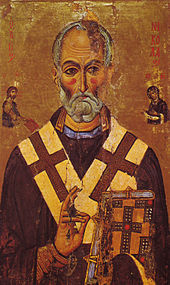
Saint Nicholas was a 4th-century Greek Christian bishop of Myra (now Demre) in the region of Lycia in the Roman Empire, today in Turkey. Nicholas was known for his generous gifts to the poor, in particular presenting the three impoverished daughters of a pious Christian with dowries so that they would not have to become prostitutes.[5] He was very religious from an early age and devoted his life entirely to Christianity. In continental Europe (more precisely the Netherlands, Belgium, Austria, the Czech Republic and Germany), he is usually portrayed as a bearded bishop in canonical robes.
In 1087, while the Greek Christian inhabitants of Myra were subjugated by the newly arrived Muslim Seljuq dynasty, and soon after their Greek Orthodox church had been declared to be in schism by the Catholic church (1054 AD), a group of merchants from the Italian city of Bari removed the major bones of Nicholas's skeleton from his sarcophagus in the Greek church in Myra. Over the objection of the monks of Myra the sailors took the bones of St. Nicholas to Bari, where they are now enshrined in the Basilica di San Nicola. Sailors from Bari collected just half of Nicholas' skeleton, leaving all the minor fragments in the church sarcophagus. These were later taken by Venetian sailors during the First Crusade and placed in Venice, where a church to St. Nicholas, the patron of sailors, was built on the San Nicolò al Lido. St. Nicholas' vandalized sarcophagus can still be seen in the St. Nicholas Church in Myra. This tradition was confirmed in two important scientific investigations of the relics in Bari and Venice, which revealed that the relics in the two Italian cities belong to the same skeleton. Saint Nicholas was later claimed as a patron saint of many diverse groups, from archers, sailors, and children to pawnbrokers.[5][6] He is also the patron saint of both Amsterdam and Moscow.[7]
During the Middle Ages, often on the evening before his name day of 6 December, children were bestowed gifts in his honour. This date was earlier than the original day of gifts for the children, which moved in the course of the Reformation and its opposition to the veneration of saints in many countries on 24 and 25 December. The custom of gifting to children at Christmas was propagated by Martin Luther as an alternative to the previous very popular gift custom on St. Nicholas, to focus the interest of the children to Christ instead of the veneration of saints. Martin Luther first suggested the Christkind as the bringer of gifts. But Nicholas remained popular as gifts bearer for the people.[8][9]
Father Christmas
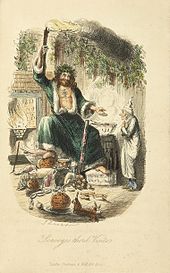
Father Christmas dates back as far as 16th century in England during the reign of Henry VIII, when he was pictured as a large man in green or scarlet robes lined with fur.[10] He typified the spirit of good cheer at Christmas, bringing peace, joy, good food and wine and revelry.[10] As England no longer kept the feast day of Saint Nicholas on 6 December, the Father Christmas celebration was moved to 25 December to coincide with Christmas Day.[10] The Victorian revival of Christmas included Father Christmas as the emblem of good cheer.[11] His physical appearance was variable,[12] with one image being John Leech's illustration of the "Ghost of Christmas Present" in Charles Dickens's festive story A Christmas Carol (1843), as a great genial man in a green coat lined with fur who takes Scrooge through the bustling streets of London on the current Christmas morning, sprinkling the essence of Christmas onto the happy populace.[10][11]
Dutch, Belgian and Swiss folklore
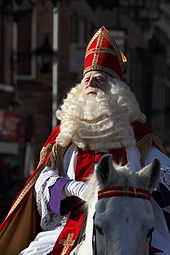

In the Netherlands and Belgium, the character of Santa Claus competes with that of Sinterklaas, based on Saint Nicolas. Santa Claus is known as de Kerstman in Dutch ("the Christmas man") and Père Noël ("Father Christmas") in French. For children in the Netherlands, Sinterklaas remains the predominant gift-giver in December; 36% of the Dutch only give presents on Sinterklaas evening or the day itself, 6 December,[13] while Christmas, 25 December, is used by another 21% to give presents. Some 26% of the Dutch population gives presents on both days.[14] In Belgium, presents are offered exclusively to children on 6 December, and on Christmas Day all ages may receive presents. Saint Nicolas/Sinterklaas' assistants are called "Pieten" (in Dutch) or "Père Fouettard" (in French), and they are not elves.[15]
In Switzerland, Père Fouettard accompanies Père Noël in the French speaking region, while the sinister Schmutzli accompanies Samichlaus in the Swiss German region. Schmutzli carries a twig broom to spank the naughty children.[16]
Germanic paganism, Wodan, and Christianization
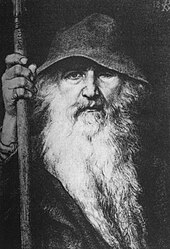
Prior to Christianization, the Germanic peoples (including the English) celebrated a midwinter event called Yule (Old English geola or giuli).[17] With the Christianization of Germanic Europe, numerous traditions were absorbed from Yuletide celebrations into modern Christmas,[18] such as the Wild Hunt, frequently attested as being led by the god Odin (Wodan), bearing (among many names) the names Jólnir, meaning "Yule figure", and Langbarðr, meaning "long-beard", in Old Norse.[19]
Wodan's role during the Yuletide period has been theorized as having influenced concepts of St. Nicholas and Santa Claus in a variety of facets, including his long white beard and his gray horse for nightly rides (compare Odin's horse Sleipnir) or his reindeer in North American tradition.[20] Folklorist Margaret Baker maintains that "the appearance of Santa Claus or Father Christmas, whose day is the 25th of December, owes much to Odin, the old blue-hooded, cloaked, white-bearded Giftbringer of the north, who rode the midwinter sky on his eight-footed steed Sleipnir, visiting his people with gifts. Odin, transformed into Father Christmas, then Santa Claus, prospered with St Nicholas and the Christchild, became a leading player on the Christmas stage."[21]
In northern Europe, the Yule goat was an earlier bearer of gifts, which has to some degree become conflated with Santa Claus, for instance in the Finnish Joulupukki tradition.[22]
History
Origins
Early representations of the gift-giver from Church history and folklore, especially St Nicholas, merged with the English character Father Christmas to create the mythical character known to the rest of the English-speaking world as "Santa Claus" (a phonetic derivation of "Sinterklaas" in Dutch).
In the English and later British colonies of North America, and later in the United States, British and Dutch versions of the gift-giver merged further. For example, in Washington Irving's History of New York (1809), Sinterklaas was Anglicized into "Santa Claus" (a name first used in the U.S. press in 1773)[23] but lost his bishop's apparel, and was at first pictured as a thick-bellied Dutch sailor with a pipe in a green winter coat. Irving's book was a parody of the Dutch culture of New York, and much of this portrait is his joking invention.[24] Irving's interpretation of Santa Claus was part of a broader movement to tone down the increasingly wild Christmas celebrations of the era, which included aggressive home invasions under the guise of wassailing, substantial premarital sex (leading to shotgun weddings in areas where the Puritans, waning in power and firmly opposed to Christmas, still held some influence) and public displays of sexual deviancy; the celebrations of the era were derided by both upper-class merchants and Christian purists.[24]
19th century
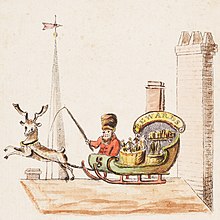

In 1821, the book A New-year's present, to the little ones from five to twelve was published in New York. It contained "Old Santeclaus with Much Delight", an anonymous poem describing Santeclaus on a reindeer sleigh, bringing rewards to children.[25] Some modern ideas of Santa Claus seemingly became canon after the anonymous publication of the poem A Visit From St. Nicholas (better known today as The Night Before Christmas) in the Troy, New York, Sentinel on 23 December 1823; Clement Clarke Moore later claimed authorship, though some scholars argue that Henry Livingston, Jr. (who died nine years before Moore's claim) was the author.[5][26] St. Nick is described as being "chubby and plump, a right jolly old elf" with "a little round belly", that "shook when he laughed like a bowlful of jelly", in spite of which the "miniature sleigh" and "tiny reindeer" still indicate that he is physically diminutive. The reindeer were also named: Dasher, Dancer, Prancer, Vixen, Comet, Cupid, Dunder and Blixem (Dunder and Blixem came from the old Dutch words for thunder and lightning, which were later changed to the more German sounding Donner and Blitzen).[27]
By 1845, "Kris Kringle" was a common variant of Santa in parts of the United States.[28] A magazine article from 1853, describing American Christmas customs to British readers, refers to children hanging up their stockings on Christmas Eve for "a fabulous personage" whose name varies: in Pennsylvania he is usually called "Krishkinkle", but in New York he is "St. Nicholas" or "Santa Claus". The author[29] quotes Moore's poem in its entirety, saying that its descriptions apply to Krishkinkle too.[30]
As the years passed, Santa Claus evolved into a large, heavyset person. One of the first artists to define Santa Claus's modern image was Thomas Nast, a German-born American cartoonist of the 19th century who immortalized Santa Claus with an illustration for the 3 January 1863 issue of Harper's Weekly in which Santa was dressed in an American flag, and had a puppet with the name "Jeff" written on it, reflecting its Civil War context. Nast was inspired by the Belsnickel, part of the folklure in southwestern Germany, where he was born.[31] In this drawing, Santa is also in a sleigh pulled by reindeers.[citation needed]
The story that Santa Claus lives at the North Pole may also have been a Nast creation. His Christmas image in the Harper's issue dated 29 December 1866 was a collage of engravings titled Santa Claus and His Works, which included the caption "Santa Claussville, N.P."[32] A colour collection of Nast's pictures, published in 1869, had a poem also titled "Santa Claus and His Works" by George P. Webster, who wrote that Santa Claus's home was "near the North Pole, in the ice and snow".[33] The tale had become well known by the 1870s. A boy from Colorado writing to the children's magazine The Nursery in late 1874 said, "If we did not live so very far from the North Pole, I should ask Santa Claus to bring me a donkey." [34]
The idea of a wife for Santa Claus may have been the creation of American authors, beginning in the mid-19th century. In 1889, the poet Katharine Lee Bates popularized Mrs. Claus in the poem "Goody Santa Claus on a Sleigh Ride". "Is There a Santa Claus?" is the title of an iconic editorial by Francis Pharcellus Church in the 21 September 1897 edition of The New York Sun that became the most reprinted in the U.S. and included the famous reply, "Yes, Virginia, there is a Santa Claus".[35][36]
In Russia, Ded Moroz emerged as a Santa Claus figure around the late 19th century[37] where Christmas for the Eastern Orthodox Church is kept on 7 January.
20th century
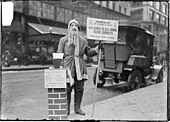
L. Frank Baum's The Life and Adventures of Santa Claus, a children's book, was published in 1902. Much of Santa Claus's mythos was not firmly established at the time, leaving Baum to give his "Neclaus" (Necile's Little One) a variety of immortal support, a home in the Laughing Valley of Hohaho, and ten reindeer—who could not fly, but leapt in enormous, flight-like bounds. Claus's immortality was earned, much like his title ("Santa"), decided by a vote of those naturally immortal. This work also established Claus's motives: a happy childhood among immortals. When Ak, Master Woodsman of the World, exposes him to the misery and poverty of children in the outside world, Santa strives to find a way to bring joy into the lives of all children, and eventually invents toys as a principal means. Santa later appears in The Road to Oz as an honored guest at Ozma's birthday party, stated to be famous and beloved enough for everyone to bow even before he is announced as "The most Mighty and Loyal Friend of Children, His Supreme Highness – Santa Claus".
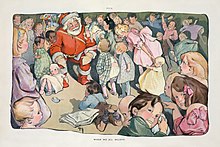
Images of Santa Claus were conveyed through Haddon Sundblom's depiction of him for The Coca-Cola Company's Christmas advertising in the 1930s.[5][38] The image spawned urban legends that Santa Claus was invented by The Coca-Cola Company or that Santa wears red and white because they are the colours used to promote the Coca-Cola brand.[39] Coca-Cola's competitor Pepsi-Cola used similar Santa Claus paintings in its advertisements in the 1940s and 1950s. Historically, Coca-Cola was not the first soft drink company to utilize the modern image of Santa Claus in its advertising—White Rock Beverages had used a Santa figure in monochrome advertisements for mineral water in 1915, and in 1923–25, the same company used colour images of Santa Claus in adverts for drink mixers.[40] Earlier, Santa Claus had appeared dressed in red and white and essentially in his current form on several covers of Puck magazine in the first few years of the 20th century.[41]
The image of Santa Claus as a benevolent character became reinforced with its association with charity and philanthropy, particularly by organizations such as the Salvation Army. Volunteers dressed as Santa Claus typically became part of fundraising drives to aid needy families at Christmas time.
In 1937, Charles W. Howard, who played Santa Claus in department stores and parades, established the Charles W. Howard Santa School, the oldest continuously run such school in the world.[42]
In some images from the early 20th century, Santa was depicted as personally making his toys by hand in a small workshop like a craftsman. Eventually, the idea emerged that he had numerous elves responsible for making the toys, but the toys were still handmade by each individual elf working in the traditional manner.
The 1956 popular song by George Melachrino, "Mrs. Santa Claus", and the 1963 children's book How Mrs. Santa Claus Saved Christmas, by Phyllis McGinley, helped standardize and establish the character and role of Mrs. Claus in the US.[43]
Seabury Quinn's 1948 novel Roads draws from historical legends to tell the story of Santa and the origins of Christmas. Other modern additions to the "story" of Santa include Rudolph the Red-Nosed Reindeer, the 9th and lead reindeer created in 1939 by Robert L. May, a Montgomery Ward copywriter, and immortalized in a 1949 song by Gene Autry.
In popular culture
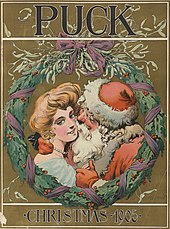

Elves had been portrayed as using assembly lines to produce toys early in the 20th century. That shift was reflected in the modern depiction of Santa's residence—now often humorously portrayed as a fully mechanized production and distribution facility, equipped with the latest manufacturing technology, and overseen by the elves with Santa and Mrs. Claus as executives or managers.[44]
In 1912, actor Leedham Bantock became the first actor to be identified as having played Santa Claus in a film. Santa Claus, which he also directed, included scenes photographed in a limited, two-tone colour process and featured the use of detailed models.[45] Since then many feature films have featured Santa Claus as a protagonist, including Miracle on 34th Street, The Santa Clause, and Elf.
In the cartoon base, Santa has been voiced by several people, including Mickey Rooney, Jim Cummings, Mel Smith, Ricky Tomlinson, Jim Belushi, and Alec Baldwin.
Santa has been described as a positive male cultural icon:
Santa is really the only cultural icon we have who's male, does not carry a gun, and is all about peace, joy, giving, and caring for other people. That's part of the magic for me, especially in a culture where we've become so commercialized and hooked into manufactured icons. Santa is much more organic, integral, connected to the past, and therefore connected to the future.
— TV producer Jonathan Meath who portrays Santa, 2011[46]
Norman Corwin's 1938 comic radio play The Plot to Overthrow Christmas, set entirely in rhyme, details a conspiracy of the Devil Mephistopheles and damned figures of history to defeat the good will among men of Christmas, by sending the Roman emperor Nero to the North Pole to assassinate Santa Claus. Through a battle of wits, Santa saves himself by winning Nero over to the joys of Christmas, and gives him a Stradivarius violin. The play was re-produced in 1940 and 1944.

Many television commercials, comic strips and other media depict this as a sort of humorous business, with Santa's elves acting as a sometimes mischievously disgruntled workforce, cracking jokes and pulling pranks on their boss. For instance, a Bloom County story from 15 December 1981 through 24 December 1981 has Santa rejecting the demands of PETCO (Professional Elves Toy-Making and Craft Organization) for higher wages, a hot tub in the locker room, and "Aggressive recruitment of a wider gender spectrum of employee" ("short broads"), with the elves then going on strike. President Reagan steps in, fires all of Santa's helpers, and replaces them with out-of-work air traffic controllers (an obvious reference to the 1981 air traffic controllers' strike), resulting in a riot before Santa vindictively rehires them in humiliating new positions such as his reindeer.[47] In the 2001 The Sopranos episode, "To Save Us All from Satan's Power", Paulie Gualtieri says he "Used to think Santa and Mrs. Claus were running a sweatshop over there. The original elves were ugly, traveled with Santa to throw bad kids a beatin', and gave the good ones toys."
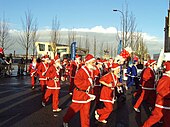
In Kyrgyzstan, a mountain peak was named after Santa Claus, after a Swedish company had suggested the location be a more efficient starting place for present-delivering journeys all over the world, than Lapland. In the Kyrgyz capital, Bishkek, a Santa Claus Festival was held on 30 December 2007, with government officials attending. 2008 was officially declared the Year of Santa Claus in the country. The events are seen as moves to boost tourism in Kyrgyzstan.[48]
The Guinness World Record for the largest gathering of Santa Clauses is held by Thrissur, Kerala, India where on 27 December 2014, 18,112 Santas overtook the previous record. Derry City, Northern Ireland had held the record since 9 September 2007, when a total of 12,965 people dressed up as Santa or Santa's helpers. Prior to that, the record was 3,921, which was set during the Santa Dash event in Liverpool City Centre in 2005.[49] A gathering of Santas in 2009 in Bucharest, Romania attempted to top the world record, but failed with only 3,939 Santas.[50]
Santa Claus has been featured in many video games.[51]
Traditions and rituals
Chimneys
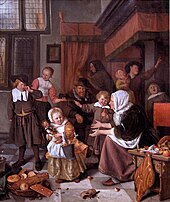
The tradition of Santa Claus being said to enter dwellings through the chimney is shared by many European seasonal gift-givers.[52]
Christmas Eve

In the United States and Canada, children may leave a glass of milk and a plate of cookies intended for Santa; in Britain, Australia and New Zealand, sherry or beer, and mince pies are left instead. In Denmark, Norway and Sweden, it is common for children to leave him rice porridge with sugar and cinnamon instead. In Ireland it is popular to leave Guinness or milk, along with Christmas pudding or mince pies.
In Hungary, St. Nicolaus (Mikulás) or Father Winter (Télapó) comes on the night of 5 December and the children get their gifts the next morning. They get sweets in a bag if they were good, and a golden coloured birch switch if not. On Christmas Eve "Little Jesus" comes and gives gifts for everyone.[53]
In Slovenia, Saint Nicholas (Miklavž) also brings small gifts for good children on the eve of 6 December. Božiček (Christmas Man) brings gifts on the eve of 25 December, and Dedek Mraz (Grandfather Frost) brings gifts in the evening of 31 December to be opened on New Years Day.
After the children have fallen asleep, parents play the role of Santa Claus and leave their gifts under the Christmas tree, which may be signed as being "from Santa Claus".[54][55][56]
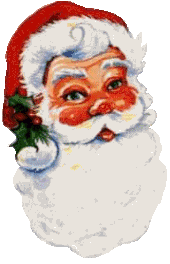
Appearance
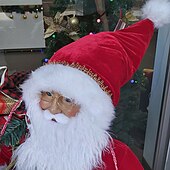

Santa is generally depicted as a portly, jolly, white-bearded man, often with spectacles, wearing a red outfit consisting of jacket, trousers and hat all trimmed with white fur, accessorized with black leather belt and boots, and carrying a bag full of gifts for children. The 1823 poem "A Visit from St. Nicholas" popularized this image in North America during the 19th century. Caricaturist and political cartoonist Thomas Nast also played a role in the creation of Santa's image.[57][58][59]
The traditional 1823 Christmas poem A Visit from St. Nicholas relates that Santa has:
"a little round belly
That shook when he laugh'd, like a bowl full of jelly"
Though most often portrayed as white, Santa is also depicted as black or of other races. His race or colour is sometimes a subject of controversy.[60][61]
Laugh
Ho ho ho is the way that many languages write out how Santa Claus laughs. "Ho, ho, ho! Merry Christmas!" It is the textual rendition of a particular type of deep-throated laugh or chuckle, most associated today with Santa Claus and Father Christmas.
The laughter of Santa Claus has long been an important attribute by which the character is identified, but it also does not appear in many non-English-speaking countries.[citation needed]
Home


Santa Claus's home is traditionally said to include a residence and a workshop where he is said to create—often with the aid of elves or other supernatural beings—the gifts he is said to deliver to good children at Christmas. Some stories and legends include a village, inhabited by his helpers, surrounding his home and shop.
Santa is traditionally said to live at the North Pole, which according to Canada Post lies within Canadian jurisdiction in postal code H0H 0H0[62] (a reference to "ho ho ho", Santa's notable saying, although postal codes starting with H are usually reserved for the island of Montréal in Québec). On 23 December 2008, Jason Kenney, Canada's minister of Citizenship, Immigration and Multiculturalism, formally awarded Canadian citizenship status to Santa Claus. "The Government of Canada wishes Santa the very best in his Christmas Eve duties and wants to let him know that, as a Canadian citizen, he has the automatic right to re-enter Canada once his trip around the world is complete," Kenney said in an official statement.[63] There is also a city named North Pole in Alaska where a tourist attraction known as the "Santa Claus House" has been established. The United States Postal Service recommends mail to Santa's workshop be sent to 123 Elf Road, North Pole, 88888.[64] The British postal service, Royal Mail, recommends letters are sent to Santa/Father Christmas, Santa's Grotto, Reindeerland, XM4 5HQ.[65]
Each Nordic country claims Santa's residence to be within their territory. Norway claims he lives in Drøbak. In Denmark, he is said to live in Greenland (near Uummannaq). In Sweden, the town of Mora has a theme park named Tomteland. The national postal terminal in Tomteboda in Stockholm receives children's letters for Santa. In Finland, Korvatunturi in Lapland has long been known as Santa's home, and two theme parks, Santa Claus Village and Santa Park are located near Rovaniemi. In Belarus, there is a home of Ded Moroz in Belovezhskaya Pushcha National Park.[66]
In France, Santa is believed to reside in 1 Chemin des Nuages, Pôle Nord (1 Alley of Clouds, North Pole). The French national postal service has operated a service that allows children to send letters to Père Noël since 1962.[67] In the period before Christmas, any physical letter in the country that is addressed to Santa Claus is sent to a specific location, where responses for the children's letters are written and sent back to the children.[68]
Parades, department stores, and shopping malls
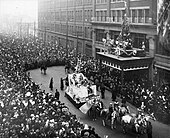

Actors portraying Santa Claus are present at various venues in the weeks leading up to Christmas. A concept devised by retail entrepreneur David Lewis, the first Christmas grotto opened in Lewis's department store in Liverpool, England in 1879.[69] The idea then took hold throughout the UK,[70] before extending to Australian and American department stores in the 1890s, with James Edgar starting in 1890 in his Brockton, Massachusetts department store.[71] Having a Santa actor set up to take pictures with children is a ritual that dates back at least to 1918.[72] An area is often set aside for the actors portraying Santa to use for the duration of the holiday season. It usually features a chair for the actors to sit in surrounded by various holiday-themed decorations. In Canada, malls operated by Oxford Properties established a process by which autistic children could "visit Santa Claus" at the mall without having to contend with crowds.[73] The malls open early to allow entry only to families with autistic children, who have a private visit with the actor portraying Santa Claus. In 2012, the Southcentre Mall in Calgary was the first mall to offer this service.[74] In the UK, the discount store Poundland changes the voice of its self-service checkouts to that of Santa Claus throughout the Christmas retail period.[75]
There are schools offering instruction on how to act as Santa Claus. For example, children's television producer Jonathan Meath studied at the International School of Santa Claus and earned the degree Master of Santa Claus in 2006. It blossomed into a second career for him, and after appearing in parades and malls,[76] he appeared on the cover of the American monthly Boston Magazine as Santa.[77] There are associations with members who portray Santa; for example, Mr. Meath was a board member of the international organization called Fraternal Order of Real Bearded Santas.[78]
Due to the COVID-19 pandemic, many Santa grottos were not operating for the 2020 Christmas season. Due to this, some companies offered video calls for a fee using apps such as Zoom where children could speak to an actor who was dressed as Santa Claus.[79]
In 2021, Walt Disney World and Disneyland featured for the first time Black cast members portraying Santa.[80]
Letter writing
Children sometimes write letters to Santa Claus, often with a wish list of presents that they wish to receive.[81][82] Some postal services recognize this tradition, and may accept letters addressed to "Santa Claus".[83] Writing letters to Santa Claus has the educational benefits of promoting literacy, computer literacy, and e-mail literacy. A letter to Santa is often a child's first experience of correspondence. Written and sent with the help of a parent or teacher, children learn about the structure of a letter, salutations, and the use of an address and postcode.[84]
According to the Universal Postal Union (UPU)'s 2007 study and survey of national postal operations, the United States Postal Service (USPS) has the oldest Santa letter answering effort by a national postal system. The USPS Santa letter answering effort started in 1912 out of the historic James Farley Post Office[85] in New York, and since 1940 has been called "Operation Santa" to ensure that letters to Santa are adopted by charitable organizations, major corporations, local businesses and individuals in order to fulfill the wishes of children.[83] Those seeking a North Pole holiday postmark through the USPS, are told to send their letter from Santa or a holiday greeting card by 10 December to: North Pole Holiday Postmark, Postmaster, 4141 Postmark Dr, Anchorage, AK 99530–9998.[86]
In 2006, according to the UPU's 2007 study and survey of national postal operations, France's Postal Service received the most letters for Santa Claus or "Père Noël" with 1,220,000 letters received from 126 countries.[87] France's Postal Service in 2007 specially recruited someone to answer the enormous volume of mail that was coming from Russia for Santa Claus.[83]
Other Santa letter processing information, according to the UPU's 2007 study and survey of national postal operations, include:[83]
- Countries whose national postal operators answer letters to Santa and other end-of-year holiday figures, and the number of letters received in 2006: Germany (500,000), Australia (117,000), Austria (6,000), Bulgaria (500), Canada (1,060,000), Spain (232,000), United States (no figure, as statistics are not kept centrally), Finland (750,000), France (1,220,000), Ireland (100,000), New Zealand (110,000), Portugal (255,000), Poland (3,000), Slovakia (85,000), Sweden (150,000), Switzerland (17,863), Ukraine (5,019), United Kingdom (750,000).
- In 2006, Finland's national postal operation received letters from 150 countries (representing 90% of the letters received), France's Postal Service from 126 countries, Germany from 80 countries, and Slovakia from 20 countries.
- In 2007, Canada Post replied to letters in 26 languages and Deutsche Post in 16 languages.
- Some national postal operators make it possible to send in e-mail messages which are answered by physical mail. All the same, Santa still receives far more letters than e-mail through the national postal operators, proving that children still write letters. National postal operators offering the ability to use an on-line web form (with or without a return e-mail address) to Santa and obtain a reply include Canada Post[88] (on-line web request form in English and French), France's Postal Service (on-line web request form in French),[89][90] and New Zealand Post[91] (on-line web request form in English).[92] In France, by 6 December 2010, a team of 60 postal elves had sent out reply cards in response to 80,000 e-mail on-line request forms and more than 500,000 physical letters.[84]
From 2002 to 2014, Canada Post replied to approximately "one million letters or more a year, and in total answered more than 24.7 million letters";[93] as of 2015, it responds to more than 1.5 million letters per year, "in over 30 languages, including Braille answering them all in the language they are written".[94] The tradition also exists in Great Britain[95] and Finland.[84]
In Latin America, letters are sometimes tied to balloons instead of being sent through the mail.[96]
An example of a public and private cooperative venture is the opportunity for expatriate and local children and parents to receive postmarked mail and greeting cards from Santa during December in the Finnish Embassy in Beijing, People's Republic of China,[97] Santa Claus Village in Rovaniemi, Finland, and the People's Republic of China Postal System's Beijing International Post Office.[98][99][100]
Tracking

A number of websites have been created by various organizations that have claimed to track Santa Claus' yearly journey. Some, such as NORAD Tracks Santa, the Google Santa Tracker, the emailSanta.com Tracker[101] and the Santa Update Project, have endured. Others, such as the Airservices Australia Tracks Santa Project,[102][103][104] the Dallas/Fort Worth International Airport's Tracks Santa Project,[105][106][107] the NASA Tracks Santa Project,[108] and the Bing Maps Platform Tracks Santa Project,[109][110] have not.

NORAD Tracks Santa originated in 1955 when a Sears-Roebuck ad incorrectly printed the number for their Santa hotline and the Continental Air Defense Command received the calls intended for the Sears hotline. The program was transferred to NORAD when it was jointly founded by the United States and Canada in 1958.[111][112]
In December 2000, the Weather Channel built upon these local efforts to provide a national Christmas Eve "Santa tracking" effort, called "SantaWatch", in cooperation with NASA, the International Space Station, and Silicon Valley–based new multimedia firm Dreamtime Holdings.[113] Currently, most local television stations in the United States and Canada rely upon outside established "Santa tracking" efforts, such as NORAD Tracks Santa.[114]
In addition to providing holiday-themed entertainment, "Santa tracking" websites raise interest in space technology and exploration,[115] serve to educate children in geography[116] and encourage them to take an interest in science.[117]
Many websites exist that claim to track Santa and his workshop. One particular website called emailSanta.com was created when a 1997 Canada Post strike prevented Alan Kerr's young niece and nephews from sending their letters to Santa; in a few weeks, over 1,000 emails to Santa were received, and the site had received 1,000 emails a day one year later.[118][119] Some websites, such as Santa's page on Microsoft's former Windows Live Spaces or emailSanta.com, have used or still use "bots" or other automated programs to compose and send personalized and realistic replies.[120][121] Microsoft's website has given occasional profane results.[122][123]
See also
Related figures
- Amu Nowruz — "Uncle New Year"; Iranian gift-bringing figure associated with spring and the new year in the traditional Iranian calendar
- Ayaz Ata — Grandfather Frost in Turkic folklore
- Badalisc
- Befana — a friendly witch who delivers gifts to children on 5 January
- Companions of Saint Nicholas
- Joulupukki — Finnish Santa Claus
- Moș Gerilă — name of a character from Romanian communist propaganda
- Olentzero — traditional Basque character who has recently been transformed into a Santa-like figure
- Saint Basil —who is believed to bring Christmas gifts for children in Greek Orthodox tradition
- The Three Kings — The Biblical three wise men brings gifts on 6 January in Spain
Other
- Jack Frost and Old Man Winter — Mythical characters associated with winter
- Christmas controversy
- Flying Santa—a northeastern US tradition of pilots delivering presents to families in remote lighthouses
- Fraternal Order of Real Bearded Santas
- Pancho Claus, a Tex-Mex version of Santa Claus
- Santa Claus, Indiana—a small Midwestern United States town named after the figure, home to Holiday World amusement park
- SantaCon
References
Citations
- ^ "Santa Claus: History, Legend, & Facts". Encyclopedia Britannica. Archived from the original on 25 December 2021. Retrieved 10 August 2020.
- ^ B. K. Swartz, Jr.; The Origin of American Christmas Myth and Customs Archived 30 April 2011 at the Wayback Machine; Retrieved 22 December 2007
- ^ Jeff Westover; The Legendary Role of Reindeer in Christmas Archived 3 August 2012 at the Wayback Machine; Retrieved 22 December 2007
- ^ "Father Christmas, green or red?". BBC. 4 December 2009.
- ^ a b c d "Santa Claus: The real man behind the myth". NBC News. 22 December 2009. Archived from the original on 1 September 2020. Retrieved 27 December 2009.
- ^ "Saint Nicholas ::: People". Stnicholascenter.org. Archived from the original on 27 December 2010. Retrieved 21 December 2010.
- ^ "Saint Nicholas ::: Places". Stnicholascenter.org. Archived from the original on 14 December 2009. Retrieved 21 December 2010.
- ^ Öller, Rudolf (2004). "Martin Luthers Christkind". Welt der Naturwissenschaften. Archived from the original on 15 February 2008. Retrieved 24 April 2023.
- ^ "Ein Verkaufsfahrer diente als Vorbild – angeblich – manager magazin". Archived from the original on 30 December 2012.
- ^ a b c d William J. Federer (2002). "There Really Is a Santa Claus: The History of St. Nicholas & Christmas Holiday Traditions" p. 39. Amerisearch, Inc., 2002
- ^ a b Jacqueline Simpson, Steve Roud (2000) "English Folklore". Oxford University Press, 2000
- ^ A children's party given in England on 26 December 1842 featured 'venerable effigies' of Father Christmas and the Old Year; '... Father Christmas with scarlet coat and cocked hat, stuck all over with presents for the guests... ' R. L. Brett, ed., Barclay Fox's Journal, Bell and Hyman, London, 1979
- ^ Davis, Derek H. (18 November 2010). The Oxford Handbook of Church and State in the United States. Oxford University Press. pp. 334–. ISBN 9780190208783. Archived from the original on 1 September 2023. Retrieved 20 December 2017.
- ^ "Nibud Pers, persberichten" (in Dutch). NIBUD. 2003. Archived from the original on 14 December 2009. Netherlands budget institute table showing money spent by households categorised into those that give gifts only on Sint (36%), only on Christmas day (21%), on both days (26%)
- ^ "Sinterklaas Arrival—Amsterdam, the Netherlands". St. Nicholas Center. 2008. Archived from the original on 17 January 2011. Retrieved 9 September 2014.
- ^ swissinfo.ch, Morven McLean (5 December 2008). "Schmutzli: the Swiss Santa's sinister sidekick". SWI swissinfo.ch. Archived from the original on 20 May 2021. Retrieved 25 December 2017.
- ^ Orchard, Andy (1997). Dictionary of Norse Mythology and Legend, page 187. Cassell.
- ^ Simek, Rudolf (2007) translated by Angela Hall. Dictionary of Northern Mythology, pages 379–380. D.S. Brewer. & Orchard (1997:1987).
- ^ For the wild hunt, Simek (2010:372–373). For Jólnir, see Simek (2010:180) and Orchard (1997:189). For Langbarðr, see Simek (2010:186).
- ^ For example, see McKnight, George Harley (1917). St. Nicholas; his legend and his rôle in the Christmas celebration and other popular customs. New York and London, G.P. Putman's sons. pages 24–26, 138–139 ; Fruehling Springwood, Charles (2009). "If Santa Wuz Black: The Domestication of a White Myth". In Denzin, Norman (ed.). Studies in Symbolic Interaction. Emerald Group Publishing. pp. 243–244. ISBN 9781848557840.
- ^ Baker, Margaret (2007 1962). Discovering Christmas Customs and Folklore: A Guide to Seasonal Rites Throughout the World, page 62. Osprey Publishing.
- ^ Sirén, Ilkka. "Does Santa Claus come from Finland?". www.bbc.com. Archived from the original on 19 April 2021. Retrieved 11 December 2018.
- ^ "Last Monday, the anniversary of St. Nicholas, otherwise called Santa Claus, was celebrated at Protestant Hall, at Mr. Waldron's; where a great number of sons of the ancient saint the Sons of Saint Nicholas celebrated the day with great joy and festivity." Rivington's Gazette (New York City), 23 December 1773.
- ^ a b Fox, Justin (13 December 2019). "Christmas Was Invented in New York: The strange but probably true tale of how Washington Irving and a few contemporaries created the modern holiday in the early 1800s". Bloomberg. Archived from the original on 20 May 2021. Retrieved 24 December 2019.
- ^ "mentioning Don Foster, Author Unknown: On the Trail of Anonymous (New York: Henry Holt, 2000: 221–75) for the attribution of Old Santeclaus to Clement Clarke Moore". Tspace.library.utoronto.ca. Archived from the original on 18 July 2011. Retrieved 21 December 2010.
- ^ Kirkpatrick, David D. (26 October 2000). "Whose Jolly Old Elf Is That, Anyway?; Literary Sleuth Casts Doubt on the Authorship of an Iconic Christmas Poem". The New York Times. ISSN 0362-4331. Archived from the original on 20 May 2021. Retrieved 8 January 2017.
- ^ "What Are the True Names of Santa's Reindeer?". snopes.com. 6 June 2001. Archived from the original on 24 April 2023. Retrieved 24 April 2023.
- ^ "Advertisement for Harrison's Bookstore". Baltimore American Republican And Daily Clipper. No. 3. 1 January 1846.
- ^ The article is signed "Uneda", an anagrammatic pen-name used by William Duane (1808–1882) of Philadelphia, son of William John Duane.
- ^ "Notes and Queries", volume 8 (217), 24 December 1853, p.615
- ^ Aktuell, S. W. R. (3 December 2023). "Wie ein Pfälzer Auswanderer den Weihnachtsmann erfand". swr.online (in German).
- ^ Thomas Nast, Santa Claus and His Works Archived 15 December 2010 at the Wayback Machine, 1866. The phrase "Santa Claussville, N.P." is on the curved border to the right of center, above the large word "Claus".
- ^ Jeremy Seal, Nicholas: The Epic Journey From Saint to Santa Claus, Bloomsbury, 2005, p. 199–200. ISBN 978-1-58234-419-5.
- ^ Armstrong, Ralph (1875). Seaverns, Fanny P. (ed.). "A letter from Colorado". The Nursery. Vol. 18. John L. Shorey. p. 43.
- ^ Dunlap, David W. (25 December 2015). "1933 - P.S., Virginia, There's a New York Times, Too". The New York Times. Archived from the original on 24 December 2021. Retrieved 25 August 2022.
- ^ Bever, Lindsey (22 December 2018). "'Is there a Santa Claus?': How a child's letter inspired the classic 'Yes, Virginia' response". The Washington Post. Archived from the original on 17 March 2022. Retrieved 25 August 2022.
- ^ Nosowitz, Dan (19 December 2019). "How Santa Survived the Soviet Era". Atlas Obscura. Archived from the original on 21 November 2021. Retrieved 1 January 2023.
- ^ "Image Gallery Santa 1931". Press Center. Coca-Cola Company. Archived from the original on 15 November 2012. Retrieved 28 October 2011.
- ^ Mikkelson, David (18 December 2008). "Did Coca-Cola Invent the Modern Image of Santa Claus?". Snopes.com. Archived from the original on 25 December 2021. Retrieved 1 January 2023.
- ^ McKay, George. "Consumption, Coca-colonisation, Cultural resistance–and Santa Claus". In Whiteley, Sheila (ed.). Christmas, Ideology and Popular Culture. Edinburgh: Edinburgh University Press. pp. 57–59.
- ^ thumb|Santa Claus on the 1902 cover of Puck magazine, thumb|Santa Claus on the 1904 cover of Puck magazine, thumb|Santa Claus on the 1905 cover of Puck magazine.
- ^ Susman, Tina (30 October 2011). "Claus and effect: The ultimate Santa school". Los Angeles Times. Archived from the original on 24 December 2017. Retrieved 20 February 2020.
- ^ How did Santa Claus become popular in American culture? Archived 4 December 2021 at the Wayback Machine, Kiwi Report, by Jaime Levis, 2 January 2019
- ^ Nissenbaum, chap. 2; Belk, 87–100
- ^ "Santa Claus (1912)". BFI.org.uk. British Film Institute. Archived from the original on 8 April 2023. Retrieved 24 April 2023.
- ^ Aldrich, Ian (November 2011). "The Big Question: Why Should We Believe in Santa? We ask Kris Kringle, a.k.a. Jonathan Meath: Why Should We Believe in Santa?". Yankee Magazine. Archived from the original on 9 February 2013. Retrieved 12 December 2012.
Santa is really the only cultural icon we have who's male, does not carry a gun, and is all about peace
- ^ "High Five! Top Five! – Bizarre Santa Claus Cameos in Comics by Robert Bazz, December 13, 2010". High Five! Comics. Archived from the original on 21 December 2010. Retrieved 25 February 2011.
- ^ Pannier, Bruce (30 December 2007). "Kyrgyzstan: Central Asian Country Welcomes Santa Claus To His New Home". Radio Free Europe/Radio Liberty. Archived from the original on 7 June 2023. Retrieved 24 April 2023.
- ^ "Largest gathering of Santa Claus". Guinness World Records. 27 December 2014. Archived from the original on 2 October 2021. Retrieved 18 October 2020.
- ^ "Guiness [sic] World Record Santa Claus Costumes | WebPhotoBlog | imagini, fotografii, pictures, poze, images". Webphoto.ro. 30 November 2009. Archived from the original on 14 October 2010. Retrieved 29 September 2010.
- ^ "10 times Santa appeared in video games". Screenwanderer.com. 25 December 2019. Archived from the original on 21 December 2021. Retrieved 21 December 2021.
- ^ Walsh, Joseph J.. Were They Wise Men Or Kings?: The Book of Christmas Questions. Westminster John Knox Press, 2001. ISBN 0-664-22312-5.
- ^ Kürti, László (2020). ""DO YOU WANT TO BE KRAMPUS?" Santa Claus, globality and locality of Christmas tradition". Hungarian Studies Yearbook. 2 (1). Sciendo: 128, 134. doi:10.2478/hsy-2020-0010. ISSN 2668-7542. S2CID 231955746.
- ^ "A Parents' Guide To Christmas: Try Not To Cry". HuffPost. 20 December 2013. Archived from the original on 5 October 2021. Retrieved 15 July 2020.
- ^ Lehr, Sarah. "Meet the parents who don't keep Santa's secret". Lansing State Journal. Archived from the original on 28 December 2021. Retrieved 15 July 2020.
- ^ Shabazz, Sa'iyda (17 April 2020). "The Heavy Price of Holiday Magic". The New York Times. ISSN 0362-4331. Archived from the original on 22 December 2021. Retrieved 15 July 2020.
- ^ "Santa's arrival lights up the Green". Archived from the original on 5 December 2012. Retrieved 2 December 2009.
- ^ Restad, Penne L. (5 December 1996). Christmas in America: A History. Oxford University Press. ISBN 9780195355093. Archived from the original on 1 September 2023. Retrieved 2 November 2020.
- ^ Auchmutey, Jim (10 December 2007). "Coke denies claims it bottled familiar Santa image". The Rocky Mountain News. Archived from the original on 12 December 2007. Retrieved 1 January 2023.
- ^ Contreras, Russell. "Santa's Ethnicity Varies in Diverse U.S." NBC 5 Dallas-Fort Worth. Archived from the original on 11 December 2022. Retrieved 11 December 2022.
- ^ "What color is Santa Claus in Appalachia?". AP NEWS. 23 December 2017. Archived from the original on 11 December 2022. Retrieved 11 December 2022.
- ^ "Canada Post – Newsroom – Letters to the Editor". 24 April 2008. Archived from the original on 24 April 2008.
- ^ "Santa Claus declared a Canadian citizen". Toronto Sun. 23 December 2008. Archived from the original on 30 December 2010. Retrieved 24 April 2023.
- ^ "USPS Operation Santa® program. FAQ". USPS. Retrieved 16 October 2024.
- ^ "Letters to Santa". Royal Mail. Retrieved 16 October 2024.
- ^ "Беловежская пуща – Фотоэнциклопедия Беларуси" (in Russian). Archived from the original on 13 May 2021. Retrieved 12 December 2015.
- ^ "Quelle est la véritable adresse du Père Noël ?". MOMES.net (in French). 25 July 2014. Archived from the original on 26 December 2021. Retrieved 26 December 2021.
- ^ Choffat, Axelle. "Lettre au Père Noël 2021 : date, adresse... Les infos clés". www.linternaute.com (in French). Archived from the original on 26 December 2021. Retrieved 26 December 2021.
- ^ "Liverpool's record breaking Christmas grotto beloved by generations". Liverpool Echo. Retrieved 15 October 2024.
- ^ "Inside the Grotto". Royal Institute of British Architects. Retrieved 16 October 2024.
- ^ Allegrini, Elaine (15 November 2008). "James Edgar's Santa Claus—the spirit of Christmas". The Enterprise. Brockton, Massachusetts. Archived from the original on 27 December 2013. Retrieved 29 November 2009.
- ^ "A Visit from St. Nick". Squareamerica.com. Archived from the original on 24 December 2010. Retrieved 21 December 2010.
- ^ DeMara, Bruce (25 November 2013). "Autistic kids get quiet time with Santa at malls". Toronto Star. Archived from the original on 24 December 2013. Retrieved 21 December 2013.
- ^ "Canadian malls offer quieter, calmer visits with Santa for kids with autism". CTVNews. 24 November 2013. Archived from the original on 20 May 2021. Retrieved 21 December 2013.
- ^ Elsom, Jack (1 November 2018). "WATCH: Elvis, Dracula and Santa entertain customers at Poundland store in Derry". Derry Now. Archived from the original on 30 August 2019. Retrieved 30 August 2019.
- ^ Edward B. Colby (3 December 2009). "Town in the spirit: Dedham Square to be filled with song, shopping". Dedham Transcript. Archived from the original on 21 July 2011. Retrieved 13 November 2010.
DEDHAM—The fifth annual Dedham Square Holiday Stroll this ... At 6 p.m., Jonathan Meath – better known as Santa JG, who performs with the Boston Pops – will entertain children and families at Cafe Video Paradiso with a sing-along with Santa. "We booked him months ago because we knew that he's in demand this time of year," Haelsen says.
- ^ Mary Ann Georgantopoulos (23 December 2007). "Miracle on Mass. Ave.: City Santa takes suit seriously". The Boston Globe. Archived from the original on 5 March 2016. Retrieved 13 November 2010.
Santa Claus is coming to town. More accurately, he's from town—Cambridge that is. Jonathan Meath is the perfect fit for a Santa.
- ^ Santa Glen, secretary (October 2010). "Minutes of meeting". San Diego Chapter of F.O.R.B.S. Archived from the original on 22 October 2010. Retrieved 13 November 2010.
Hello fellow Santas, Once again we had an informative and fun gathering. Ten Santas were in attendance and we were happy to welcome Karilyn Curran, the chair person of our up and coming Santa Luncheon for 2011. ... Fashion Show: ... Jonathan Meath ...
- ^ "Santa to visit virtually as Christmas grottos cancelled". BBC News. 5 November 2020. Archived from the original on 6 August 2021. Retrieved 17 November 2020.
- ^ Chang, Rachel. "There Are Now Black Santas at Walt Disney World and Disneyland for the First Time in History". Travel + Leisure. Meredith. Archived from the original on 21 December 2021. Retrieved 1 December 2021.
- ^ Halkoaho, Jenniina; Laaksonnen, Pirjo (2009). "Understanding What Christmas Gifts Mean to Children" (PDF). Young Consumers. 10 (3): 251. doi:10.1108/17473610910986053. Archived from the original (PDF) on 27 September 2011. Retrieved 12 December 2010.
- ^ Otnes, Cele; Kim, Kyungseung; Kim, Young Chan (1994). "Yes, Virginia, there is a gender difference: Analyzing children's requests to Santa Claus". Journal of Popular Culture. 28 (1): 23. doi:10.1111/j.0022-3840.1994.2801_17.x.
- ^ a b c d "Santa Claus receives more than six million letters annually and growing, 20 Dec 2007". Asian Tribune. Archived from the original on 8 May 2011. Retrieved 12 December 2010.
- ^ a b c "No small job for postal elves, 15 Dec 2010". Universal Postal Union – UPU. Archived from the original on 22 December 2010. Retrieved 17 December 2010.
- ^ "Operation Santa Claus at James Farley Post Office 2012 | Operation Santa Claus – Santa's Blog". 15 November 2011. Archived from the original on 28 November 2011. Retrieved 10 December 2011.
- ^ "Santa Mail – Letters to Santa". Archived from the original on 12 November 2020. Retrieved 25 November 2014.
- ^ "France answers the most Santa letters, 21 Dec 2007". xmas.co.uk. 21 December 2007. Archived from the original on 17 March 2012. Retrieved 12 December 2010.
- ^ "Canada Post – Holiday – Santa's Corner". Canadapost.ca. Archived from the original on 25 December 2010. Retrieved 21 December 2010.
- ^ "LA POSTE | Père Noël" (in French). Laposte.fr. Archived from the original on 20 July 2011. Retrieved 21 December 2010.
- ^ "Father Christmas's French office open, 18 Nov 2010". The Connexion. Archived from the original on 13 December 2010. Retrieved 12 December 2010.
- ^ "Send a letter to Santa | New Zealand Post". Nzpost.co.nz. Archived from the original on 21 January 2012. Retrieved 21 December 2010.
- ^ "NZ Post to tighten net for Santa, by Alexis Grant, 30 Nov 2004". The New Zealand Herald. 30 November 2004. Archived from the original on 10 August 2011. Retrieved 12 December 2010.
- ^ "Time to write to Santa!". Canada Post. 19 November 2015. Archived from the original on 9 April 2016. Retrieved 2 August 2016.
- ^ "Write to Santa and he'll write you back!". Canada Post. 5 November 2015. Archived from the original on 17 August 2016. Retrieved 2 August 2016.
- ^ "Christmas letters to Santa". Royal Mail. Archived from the original on 19 June 2018. Retrieved 27 December 2013.
- ^ 'Letters to Santa Claus'. (2000). In The World Encyclopedia of Christmas. Gerry Bowler, Editor. Toronto: McClelland & Stewart Limited. pp. 131–132.
- ^ "About this site – Embassy of Finland, Beijing – Consulates General of Finland, Shanghai and Guangzhou: Current Affairs". Finland.cn. 16 May 2007. Archived from the original on 11 July 2007. Retrieved 21 December 2010.
- ^ "Beijing Post Office". Beijing Your Way. Archived from the original on 7 July 2011. Retrieved 21 December 2010.
- ^ "Beijing International Post Office". Vip.fesco.com.cn. Archived from the original on 7 January 2008. Retrieved 21 December 2010.
- ^ "Say hello to Santa Claus, November 24, 2010 by Zhao Hongyi". Beijing Today. Archived from the original on 1 December 2011. Retrieved 12 December 2010.
- ^ Ribeiro, Ricky. "EmailSanta.com: How Santa Claus Went Digital". BizTech Magazine. Archived from the original on 12 November 2021. Retrieved 19 July 2020.
- ^ "Santa 2010 website by Airservices Australia". Mirror.airservicesaustralia.com. Archived from the original on 20 December 2010. Retrieved 21 December 2010.
- ^ "Safe Travels Santa! We will Be Watching, 19 Dec 2005". NASA's Canberra Deep Space Communications Complex. Archived from the original on 16 February 2011. Retrieved 4 December 2010.
- ^ "New technology to map Santa's flight, 24 Dec 2009". The Observer. Archived from the original on 6 July 2011. Retrieved 5 December 2010.
- ^ "DFW airport unveils Santa Tracker website, 18 Dec 2006". PegNews wire. Archived from the original on 26 August 2011. Retrieved 4 December 2010.
- ^ "DFW Airport's 'Santa Tracker' Is Operational, by BJ Austin, 24 Dec 2009". PBS KERA. Archived from the original on 5 August 2011. Retrieved 4 December 2010.
- ^ "From NORAD Santa Tracker To Twitter: Santa Tracking For Christmas Eve 2009, by Danny Sullivan, 23 Dec 2009". Search Engine Land. 24 December 2009. Archived from the original on 21 May 2011. Retrieved 5 December 2010.
- ^ "Here Comes Santa Claus! Watch it on the Web!, 24 Dec 2005". WRAL.com – Raleigh, Durham, Fayetteville – North Carolina's TV Station website. Archived from the original on 8 August 2011. Retrieved 4 December 2010.
- ^ "Welcome to The North Pole – A Virtual Earth 3D Experience!". MSNBC. Archived from the original on 11 August 2011. Retrieved 21 December 2010.
- ^ "Tracking Santa with Bing Maps, by Chris Pendleton, 24 Dec 2009". Microsoft. Archived from the original on 1 January 2010. Retrieved 5 December 2010.
- ^ Gurnon, Emily (23 December 2014). "How A Sears Typo Led To NORAD's Santa Tracker". Forbes. Archived from the original on 20 May 2021. Retrieved 24 December 2014.
- ^ "Norad Santa Tracker: Christmas tradition began with a wrong number". CBC News. CBC. 24 December 2014. Archived from the original on 25 December 2014. Retrieved 24 December 2014.
- ^ "SantaWatch: Hunt for Santa to Include Clues from the International Space Station, by Dreamtime, 18 Dec 2000". Dreamtime. 18 December 2000. Archived from the original on 27 December 2021. Retrieved 11 December 2010.
- ^ "Keep track of Santa thanks to NORAD, by WKTV News, 24 Dec 2009". Dreamtime. Archived from the original on 27 September 2011. Retrieved 11 December 2010.
- ^ "NORAD Tracks Santa – Citation – Space Certification Program as a Corporate Patron Level Partner in the Certified Imagination Product Category, December 2007". Space Foundation. Archived from the original on 25 September 2010. Retrieved 31 December 2009.
- ^ "Hi-tech helps track Santa Claus, December 24, 2008". BBC News. 24 December 2008. Archived from the original on 16 September 2021. Retrieved 31 December 2009.
- ^ "You'd Better Not Pout! Booz Allen Supports NORAD to Track Santa's Approach This Year, December 1, 2010 by Booz Allen Hamilton". Booz Allen Hamilton. Archived from the original on 10 December 2010. Retrieved 1 December 2010.
- ^ Rueb, Emily S. (21 December 2019). "Trying to Reach the North Pole? Check Your Wi-Fi". The New York Times. ISSN 0362-4331. Archived from the original on 3 November 2021. Retrieved 14 June 2020.
- ^ "Calgary Santa receives wishes and cries for help in emails from around the world". Calgary Herald. Archived from the original on 4 November 2021. Retrieved 14 June 2020.
- ^ Ribeiro, Ricky (19 December 2012). "EmailSanta.com: How Santa Claus Went Digital". BizTech Magazine. Archived from the original on 12 November 2021. Retrieved 19 July 2020.
It now offers kids and parents personalized messages from Santa, which run from an ASP script that Kerr built himself.
- ^ Vnuk, Helen (7 December 2017). "Email Santa and get a reply: the website making my kids believe". MamaMia.com.au/. Archived from the original on 2 November 2021. Retrieved 19 July 2020.
The one thing that's convinced my daughter, more than anything else, that Santa is real is a website, emailSanta.com.
- ^ "Microsoft pulls plug on potty-mouth Santa, by John Fontana, 4 Dec 2007". Network World. Archived from the original on 13 October 2012. Retrieved 9 December 2010.
- ^ "For a Jolly Good Time, Chat With Santa on Windows Live Messenger, 13 Dec 2006". Microsoft. Archived from the original on 24 October 2007. Retrieved 9 December 2010.
General and cited references
- Belk, Russell. 1989. "Materialism with the modern U.S. Christmas Archived 1 December 2011 at the Wayback Machine". In Interpretive Consumer Research, ed. by Elizabeth C. Hirschman, Provo, UT: Association for Consumer Research, 75–104.
- Bowler, Gerry, Editor (2004). The World Encyclopedia of Christmas Archived 28 October 2012 at the Wayback Machine, Toronto: McClelland & Stewart Limited. ISBN 978-0-7710-1535-9 (0-7710-1535-6)
- Bowler, Gerry, (2007). Santa Claus: A Biography Archived 28 October 2012 at the Wayback Machine, Toronto: McClelland & Stewart Limited. ISBN 978-0-7710-1668-4 (0-7710-1668-9)
- Crump, William D. Editor (2006). The Christmas Encyclopedia, 2nd edition Archived 9 March 2012 at the Wayback Machine, Jefferson, North Carolina: McFarland & Company, Inc., Publishers, ISBN 978-0-7864-2293-7
- Nissenbaum, Stephen (1997). The Battle for Christmas Archived 6 October 2021 at the Wayback Machine, New York: Alfred A. Knopf, ISBN 978-0-679-74038-4 (0-679-74038-4)
Further reading
- Joffe-Walt, Chana (19 December 2012). "Without Magic, Santa Would Need 12 Million Employees". All Things Considered. NPR. Retrieved 20 December 2012.
External links
- An article on the History of Santa Claus from the St. Nicholas Center
- The History of Santa Claus and Father Christmas
- Research guides for Thomas Nast and Santa Claus at The Morristown & Morris Township Public Library, NJ
- "The Knickerbockers Rescue Santa Claus: 'Claas Schlaschenschlinger' from James Kirke Paulding's The Book of Saint Nicholas" (1836)
- NORAD Tracks Santa
- emailSanta.com Tracker
